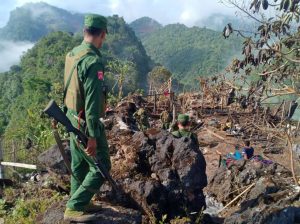Since late last week, senior Chinese officials have held a flurry of talks with Myanmar’s military administration focusing on border security, after an ethnic armed group completed its capture of the Kokang region in northern Shan State.
According to a statement from China’s Foreign Ministry, Vice Foreign Minister Sun Weidong visited Myanmar during January 4-6, and met with junta chief Senior General Min Aung Hlaing, the South China Morning Post reported.
Sun’s meeting with Min Aung Hlaing on Friday, which was reportedly attended also by Ambassador Chen Hai and regional special envoy Deng Xijun, saw the two sides discuss topics including border stability and on online scam operations.
“The two sides will jointly maintain peace and stability on the China-Myanmar border, cooperate to combat cross-border criminal activities such as telecommunications fraud, and jointly promote regional peace, tranquility, development and prosperity,” the Chinese Foreign Ministry said in a statement, the South China Morning Post reported.
The same day, China’s minister of public security, Wang Xiaohong, also held a video call with Lt. Gen. Yar Pyae, the junta’s home affairs minister, the ministry added.
This statement was given an ironic inflection by events late Thursday, when the Myanmar National Democratic Alliance Army (MNDAA) completed its reconquest of the Kokang Self-Administered Zone (SAZ) in northern Shan State. The fall of Laukkai, the zone’s capital, saw the surrender of 2,389 soldiers, including six brigadier generals. The MNDAA governed Kokang until it was driven out of power by the Myanmar military in 2009.
According to the surrender agreement, the junta forces were granted safe passage to Lashio, some 186 kilometers to the southwest, along with 1,601 family members, after giving up most of their weapons. The MNDAA’s recapture of Kokang, undertaken as part of Operation 1027, which the group launched with its two allies in the Three Brotherhood Alliance in late October, marks the most significant defeat for the military junta that seized power in February 2021. One prominent observer described it as “the largest surrender in the history of Myanmar’s military.”
China naturally has concerns about the resumption of conflict, which has displaced tens of thousands of civilians in the border region and seen major disruptions to the cross-border trade between China and Myanmar. Last week, an artillery shell from Myanmar was reported to have fallen on the town of Nansan in China’s Yunnan province, around 8 kilometers from Laukkai, prompting a Chinese Foreign Ministry spokesperson to call on “all parties to the conflict to cease fire and stop fighting, and take measures to prevent the recurrence of such vicious incidents.”
Another pressing Chinese concern are the telecoms scams that have flourished throughout the border regions, targeting Chinese and foreign nationals alike. Beijing had reportedly grown frustrated with the military-aligned Border Guard Force that ruled Kokang until last week, which refused Chinese demands to crack down on the operations – in large part because they were being run by Chinese crime families with close ties to the Kokang leadership.
These concerns prompted the Chinese government to take a hands-off approach when the MNDAA and its allies launched Operation 1027, claiming publicly that the closure of Kokang’s scam centers was one of the offensive’s primary objectives.
The through-line of China’s policy toward northern Shan State has been the establishment and maintenance of the stability necessary for the expansion of border trade and the construction of an ambitious transport corridor linking China’s Yunnan province to Myanmar’s Indian Ocean coast. Pessimistic about the prospects of a sustained peace in northern Shan State, the Chinese government has favored ad hoc ceasefire arrangements that have permitted these objectives to move ahead.
It is for these reasons that the Chinese government has tried – so far unsuccessfully – to broker a ceasefire between the Three Brotherhood Alliance and the Myanmar military, hosting two rounds of peace talks in Kunming. A third is scheduled to take place later this month.
According to a Global Times report about Sun’s meeting with Min Aung Hlaing, the Chinese special envoy “stressed China’s commitment to continuing to play a constructive role in supporting the peace process in northern Myanmar.” It added, “China endeavors to facilitate a ceasefire and talks in the northern regions of Myanmar have been driven by the hope that all parties prioritize peace and stability, exercise maximum restraint and actively de-escalate tensions.”
The talks suggest that China is not about to undertake a significant shift in its policy toward Myanmar, even as the military administration continues to lose ground to the country’s broad-based resistance. It also suggests that Beijing views the return of Kokang to MNDAA control as the possible prelude to a sustainable ceasefire and the return of stability to the borderlands.
What Chinese officials are thinking privately about the junta’s future prospects, however, is another question.

































